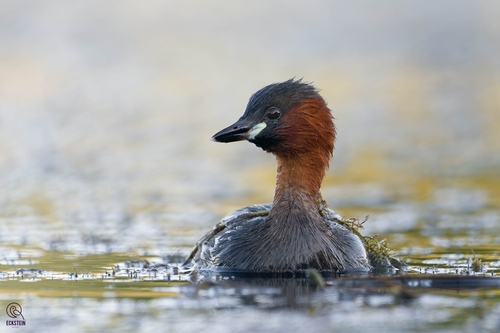
Little Grebe
The Little Grebe (Tachybaptus ruficollis), also known as the Dabchick, is a small, charming waterbird widely distributed across Europe, Asia, and Africa. It is a member of the grebe family, known for their elaborate courtship displays and ability to dive and swim underwater with exceptional skill. Little Grebes play a crucial role in their wetland ecosystems, primarily as predators of small fish and aquatic invertebrates. They are not considered globally threatened, demonstrating a remarkable adaptability to various freshwater habitats, including those significantly altered by human activity.
23-29 cm
Length
40-45 cm
Wingspan
Least Concern
Conservation Status
Distribution
The Little Grebe has a broad distribution, found throughout Europe, much of Asia south of the Himalayas, and across most of sub-Saharan Africa. It is also found in parts of the Middle East and the Indian subcontinent. Some populations are migratory, moving to ice-free waters in winter, while others are resident year-round.
Lifespan
Typically 5-10 years in the wild, although some individuals may live longer.
Little Grebe's Habitat
Habitat Types
Freshwater lakes, Ponds, Slow-flowing rivers, Marshes, Reedbeds, Coastal lagoons (occasionally)
Climate Zones
Temperate, Tropical, Subtropical
Adaptations
Little Grebes have lobed toes, rather than webbed feet, which provide excellent propulsion underwater. Their legs are positioned far back on their bodies, making them efficient swimmers but awkward on land. They can also adjust their buoyancy, allowing them to float low in the water or submerge completely.
Variations
Several subspecies are recognized, differing slightly in size and plumage coloration. For example, *T. r. capensis* is found in sub-Saharan Africa, while *T. r. iraquensis* is found in Iraq and southwestern Iran.
Appearance
Breeding Plumage
Breeding plumage features rich chestnut-red neck and cheeks, with a glossy black crown and back. Non-breeding plumage is duller, with a brownish-grey neck and back, and a paler throat.
Seasonal Feather Changes
The change between breeding and non-breeding plumage is gradual, occurring through molting.
Sex Based Plumage Differences
Males and females have similar plumage, although males may be slightly brighter during the breeding season.
Notable Features
Small, compact body, Short, pointed bill, Lobed toes (not webbed), Bright yellow gape (visible during breeding season)
Diet and Feeding
Primary Foods
Small fish, Aquatic insects, Crustaceans, Mollusks, Amphibian larvae
Foraging Behavior
Little Grebes are expert divers, pursuing prey underwater. They typically dive for 10-25 seconds, but can stay submerged longer if necessary. They often forage in areas with submerged vegetation.
Specializations
Their lobed toes and posteriorly positioned legs are key adaptations for underwater pursuit. Their small size allows them to maneuver effectively in dense vegetation.
Seasonal Diet Variations
Diet may vary slightly depending on the availability of prey. In winter, they may consume more crustaceans if insects are less abundant.
Behavior
Social Structure
Little Grebes are generally territorial during the breeding season, defending their nesting area from other grebes. Outside of breeding, they may form small, loose flocks.
Communication
A high-pitched, trilling call (often described as a 'whinnying' sound), Visual displays (e.g., head-shaking, raising neck feathers)
Migration
Some populations are migratory, undertaking short- to medium-distance movements to find ice-free water in winter. Others are resident year-round.
Territorial or Group Behaviors
During breeding, pairs aggressively defend their territory. They may engage in chases and physical confrontations with intruders.
Conservation
Threats
Habitat loss and degradation (due to drainage, pollution, and development), Disturbance from human activities (e.g., boating, fishing), Predation (by birds of prey, mammals, and large fish), Entanglement in fishing gear
Protection Programs
Habitat restoration and protection projects, Legal protection under national and international wildlife laws, Monitoring of populations
Local National Laws
Protected under various national laws, such as the Wildlife and Countryside Act 1981 in the UK.
Population Trend
Stable
Population Estimates
The global population is estimated to be between 610,000 and 3,500,000 individuals.
Interesting Facts
Little Grebes swallow their own feathers.
This behavior is thought to help protect the stomach lining from sharp fish bones and to aid in the formation of pellets of indigestible material, which are regurgitated.
Chicks often ride on their parents' backs.
This provides warmth, protection from predators, and a convenient way to travel across the water.
They can sink slowly and silently below the water's surface.
This 'submarine' behavior helps them to avoid predators or to approach prey undetected.
Faqs about Little Grebe
What is the difference between a Little Grebe and a duck?
Little Grebes are not ducks. They belong to a separate family (Podicipedidae) and have lobed toes instead of webbed feet. They are also generally smaller and more compact than most ducks.
Where can I see Little Grebes?
Little Grebes can be found on a variety of freshwater habitats, including lakes, ponds, slow-flowing rivers, and marshes. Look for them near areas with emergent vegetation.
Are Little Grebes endangered?
No, Little Grebes are classified as 'Least Concern' by the IUCN. Their populations are generally stable, although they face localized threats from habitat loss and disturbance.
Copyright @ Nature Style Limited. All Rights Reserved.
 English
English